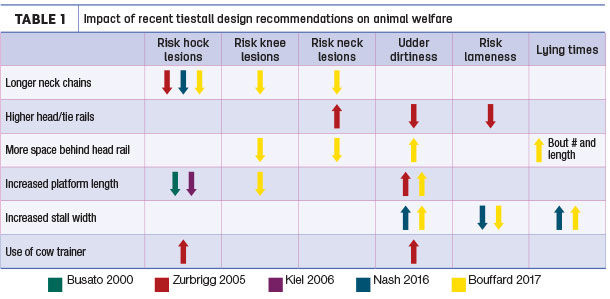As we move past tail docking, down cows and the handling of dairy cattle on our farms, there are a number of other welfare concerns emerging for us to address in the near future. These issues are voiced by consumers through social media, open discussion with food marketers and are often amplified by animal activism groups.
At the top of the list of concerns is the restriction of movement imposed by stanchion and tiestall housing. This issue has spread from the discussion in the swine and poultry industry regarding tethering and cage sizes. There is some scientific evidence available to support the stance that restricted movement impacts the ability of cows to rest comfortably and diminishes cow health.
However, much of this evidence comes from Northern Europe, reviewing the comfort of older facilities, which was used to end this type of housing in countries such as Norway. Importantly, this work did not address the more recently designed tiestalls stemming from the work of Dr. Neil Anderson in Ontario, Canada.
These improvements (Table 1) have significantly improved the physical well-being of dairy cattle when implemented across five different studies.

However, they have been associated with a decrease in udder hygiene, and it is unclear how widespread the implementation of these recommendations have been. (Dairy cow comfort tie-stall dimensions.)
While 39 percent of U.S. dairy herds use tiestall housing, 73 percent of these herds incorporate some untethered exercise outside the barn – making a distinction between this type of management and other types of livestock housing where animals are tethered day after day.
A period of 1.5 to 2 hours per day of exercise has been shown to reduce the risk for injury, lameness and illness in some studies, and we will likely need to stress the importance of this daily release from the stalls if tiestalls are to survive into the future. Those tiestall herds where cows are permanently tethered will likely need to find a way to provide for exercise – not necessarily outside at pasture, but possibly in a bedded pack or covered loafing area.
Freestall-housed herds have not escaped concerns regarding the freedom of cows to roam outside the barn. We have invested considerable effort over recent years emphasizing the importance of cow comfort in our freestall facilities, yet this is not enough for some consumers.
There remains a significant expectation that dairy cows should graze on pasture – likely enforced by the marketing practices of our industry when we repeatedly use pastoral images of cow management to market milk products.
Perhaps we need to begin to challenge this assumption - that cows should graze. Several studies have now shown that when we give cows the choice between housing and pasture, they choose both. They prefer to be in the barn during the day and during inclement weather, and outside at night – suggesting there are elements of housing that they quite like.
While the cow’s ancestor, the auroch, was certainly a grazing animal, I view a modern high-producing dairy cow about as similar to the auroch as a pet dog is to its ancestor – the wolf. Our consumers do not keep their pet dogs in packs and feed them live animals, so perhaps we could work on their expectation that our cows should graze?
Hopefully, we can find some middle ground where they accept that our cows can thrive in a well-designed barn, and perhaps we can build in a system where some of our cows are let outside, some of the time.
Calf management is another area of concern. Research is showing us that there are behavioral and health benefits to group raising calves from a young age, provided we adjust their feeding management to optimize caloric intake. While many herds stress the need to raise calves individually for health management, there are clearly social effects of this isolation that have a negative impact on welfare.
Fortunately, recent studies show that we can get most of the benefits of group raising by pair-raising calves on milk. That means we can easily adapt our hutch and individual pen systems to accommodate this change in management, which should be an industry priority.
However, one other area of concern related to calf management is not so easily solved. When consumers are made aware that we remove calves from their mothers within hours of birth, they have a significant negative reaction. This practice has been arrived at to reduce stress on the mother, improve colostrum management and aid the control of fecal-oral pathogens such as paratuberculosis and salmonella.
If we are to fund a successful alternative approach to address this concern, we are going to need to update the science behind this practice, question our assumptions once more and explore new possibilities.
One thing is very clear – the welfare discussion with our consumers will not go away. It will continue to evolve, and we must listen to the questions raised by moderates and act on these concerns, lest we will be forced into something by extremists that we will find hard to live with.
It is my hope that as an industry, we will continue to be judged on the outcomes of animal health and welfare and focus less on the process. Advances in animal welfare, where we motivate producers to embark along a path of continuous improvement, allow them to achieve the optimal outcome that suits their management situation. ![]()
Nigel Cook is currently chair of the department of medical sciences at the University of Wisconsin – Madison School of Veterinary Medicine and manages the Dairyland Initiative.

-
Nigel B. Cook
- Veterinarian
- UW – Madison, School of Veterinary






